Religion
in Wales
Church and chapel
|
|
|
|
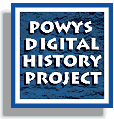
Photographs by
kind permission of
Radnorshire Museum
|
|
INDEX
|
Old Puritanism
Ripe for the Gospel
Welsh Methodism
A Church divided
The Anglican Church in Wales
Church and State
The pressure for change
The heyday of nonconformity
|
|
Old
puritanism
|
|
The
resilience of puritanism
Despite persecution and the
exodus of many Welsh Quakers,
nonconformity in the early
eighteenth century clung on in
small communities. Old
puritanism had survived, and was
particularly resilient in
Breconshire where
Congregationalists and Baptists
were the most common sects,
often meeting in scattered
groups at private houses.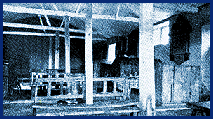
The Toleration Act of
1689 allowed dissenters to
worship freely in licensed
meeting houses. Even though
their members were still
excluded from universities and
public office, the dissenting
sects had some protection in
law. Their members were a small
but influential minority in
society, particularly in
anglicised south Wales.
The
first chapels in Powys
Among the earliest chapels or
meeting houses in Powys were
Maesyronnen chapel (above) in
Glasbury parish, and the Quaker
Meeting House at The Pales near 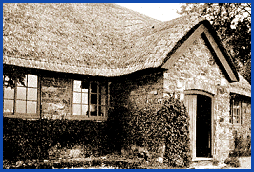 Llandegley
(right), both examples
being in remote locations. Llandegley
(right), both examples
being in remote locations.
In the early period in the
eighteenth century there was a
great surge in the publishing
and distribution of Welsh bibles
and tracts, and translated works
like Bunyan’s Pilgrim’s
Progress.
The Welsh Trust
and the Society for the
Promotion of Christian Knowledge
worked hard to distribute
subsidised works, and a Welsh
bible became a family treasure,
even among many poor labouring
families. This not only
encouraged literacy, but
prepared the ground for a
grass-roots response to
Methodism.
|
Ripe
for the Gospel
|
|
Familiarity
with the bible
The spread of new
church and dissenting schools
meant that many of the poorest
households had one literate family
member who could read the Bible
and other works to assembled
family and friends, and the
resultant familiarity with the
bible and awareness of new
religious ideas meant that Wales
did indeed become, as John Wesley
claimed, ‘ripe for the
Gospel’.
The Church of England clergy in
Wales in the first half of the
eighteenth century was a clergy
divided by wealth and culture. The
bishops were often English or
Scottish, with a reluctance to
visit their dioceses and an
antipathy or indifference to the
Welsh language. They tended to
appoint like-minded clergy to the
more affluent livings, who would
then turn over the running of the
parish to poverty- stricken clergy
who could not carry out their
duties effectively. This also
affected the poorer mountain
livings where clergy struggled to
make ends meet.
Uncaring
clergy
Many of the clergy appointed by
the bishops were not Welsh
speakers. This caused much
resentment in north Wales, and
there grew across Wales a general
feeling that many Church of
England clergy were uncaring of
the needs of their parishioners.
The discontented and
newly-literate Welsh rural
population became exposed to the
force of three dynamic
personalities which were the
engine of revivalism in Wales.
These were William Williams,
Daniel Rowland and Howell Harris
of Trefecca in Breconshire. All
three saw themselves as a part of
the traditions of the established
church, but sought to energise the
church and directly involve
individual parishioners in an
awareness of the gospel message.
|
|
|
Welsh Methodism
|
|
The Revival in Wales
From the mid-1730s onward, William Williams, Daniel Rowland, and
Howell Harris were involved in an exhausting campaign to bring about
this new awareness of the gospel message through preaching. All
three were successful in attracting large gatherings of people, who
found that the sense of involvement generated at these meetings was
more exciting than the formal parish services, or less exclusive
than nonconformity. The heady emotional atmosphere of the meetings
and their theatricality made them very different to most
nonconformist practices.
Although Welsh methodism had close links with Wesley and the
English movement it was essentially Calvinist, and had established
its own structure through a network of seiadau or regular
meetings with their own superintendents. Even so this was a movement
aimed at reviving the established church, and members were
instructed to take communion at their parish church.
 Threat
to authority Threat
to authority
The senior hierarchy of the Church of England saw the revival as a
threat to the natural authority of the gentry. Howell
Harris (right) appears to have been refused
ordination unless he was willing to give up itinerant preaching and
settle in a parish, and he and other prominent Welsh methodist
leaders were attacked by angry mobs. The most serious incident at
this time was the killing of William Seward at Hay.
Although this early period was important to Welsh religious history,
methodism did not become a large scale popular movement until later
in the eighteenth century. Some methodist groups left the Church of
England, and thus enjoyed the legal protection afforded to licensed
nonconformist groups.
Howell Harris himself split the movement in Wales by following a
doctrine which claimed that God himself had died on the cross. This
led to his disowning by the movement and his concentration on
setting up his own religious community at Trefecca.
|
|
|
A church divided
|
|
Political awareness
As the eighteenth century progressed the changes in farming and
landscape use, particularly the enclosure of common land, and the
new opportunities offered by the developing industrial centres,
added to the sense of turmoil in Wales. There was also a growing
political awareness among the newly literate sections of the working
classes. This led to the establishment of a small minority of
Arminians and Unitarians, who, unlike the revivalists, believed that
man and his powers of reason had a role to play in salvation. At a
time when America and France had challenged the old order this was
seen as threat and even the relatively reactionary methodists
suffered persecution. This led to congregations leaving the Church
of England and seeking the protection of the Toleration Act.
Increased influence of methodism
The period 1790 to 1810 was one of consolidation for Welsh methodism,
with the movement being strengthened by the spread of sunday
schools. Many congregations began to elect their own elders, and the
movement away from the established church seemed inevitable to many.
In 1811 the Calvinistic Methodist denomination was founded and,
although local congregations probably did not yet see it that way,
Welsh methodism had joined the ranks of nonconformity. Although
Wesley had not sought Welsh recruits his preaching tours to the
principality did have an influence. Wesley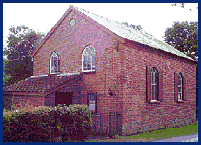 an
groups were established with leaders like Thomas Coke of Brecon
being active in creating a Welsh Mission. an
groups were established with leaders like Thomas Coke of Brecon
being active in creating a Welsh Mission.
The chapel pictured (right) near Betws Cedewain dates from
1795. The Wesleyan Conference was highly centralised, however, and
even Welsh language congregations were part of an English based
structure.
Massive expansion
The first half of the nineteenth century was a period of massive
expansion for all nonconformist sects in Wales, with the equivalent
of one chapel being built every eight days. Itinerant preachers were
able to stir up enthusiasm, particularly in the new industrial areas
where the old parish system meant that the Church of England was
slow to respond to the needs of the new population centres.
Here local people took up the challenge of creating their own places
of worship where ordinary member of the congregation had a genuine
sense of involvement, and which were the focus for a great range of
other activities.
|
The Anglican church in Wales
|
|
A new network of schools
In contrast to the vibrant nonconformist sects, the Church of
England often seemed remote and anglicised and too closely
associated with the land owning classes.
The growing number of evangelicals within the church were anxious
about the massive success of nonconformity, and the National
Society was founded in 1811 with the intention of creating a
network of schools where the children of the poor would be taught in
accordance with the beliefs of the established church. These schools
benefited from the support system of the diocesan structure and the
endowments of the gentry.
In 1833 there were almost 150 National schools in Wales, and by 1847
there were a further 231.
Safeguarding Welsh culture
In the early 19th century, Bishop Thomas Burgess of St David’s
strove to meet the challenge. 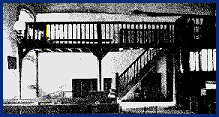 He
was a supporter of Welsh language preaching in church and was behind
the creation of the Cambrian Societies which organised local eisteddfodau.
Clergy in border parishes like Kerry and Abergavenny were active
in safeguarding Welsh literature and culture. He
was a supporter of Welsh language preaching in church and was behind
the creation of the Cambrian Societies which organised local eisteddfodau.
Clergy in border parishes like Kerry and Abergavenny were active
in safeguarding Welsh literature and culture.
In 1847 a damning report of a commission into the provision of
education in Wales was published. The commissioners totally failed
to understand the difficulties of educating Welsh speaking children
in English, and their prejudices were further fed by the evidence of
some clergy who blamed poor educational performance on a chapel
upbringing. There was a violent tide of resentment against this
report and against the Anglican Church, and for many years the
clergy had to contend with the feeling in many circles that the
church had somehow betrayed the Welsh people.
|
Church and state
|
|
A census on religious belief
The Religious Census of 1851 put the church in second place to
nonconformity in Wales, although the substantial minority of people
who did not take part in any religious observance are often
overlooked in the equation.
The Census fuelled the movement for a break between church and
state. If the established church only represented a minority of the
people in Wales why should it enjoy the power of the state, and why
should it enjoy the tithe payments of the mass of nonconformists?
The campaign for a separate Church in Wales electing its own bishops
was not completely achieved until 1920, but the second half of the
nineteenth century was one in which the Anglican Church in Wales
rose to the new challenge and experienced its own revival.
Meeting new needs
Between 1870 and 1920 the Welsh bishops - appointed by successive
Prime Ministers - were all Welsh speaking. They successfully addressed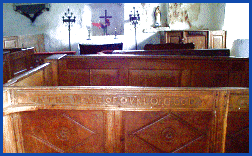 the problems of earlier years like the non-residence of
parish clergy, and this was a period of tremendous church
construction as parishes were re-drawn to meet the needs of a
changing population. the problems of earlier years like the non-residence of
parish clergy, and this was a period of tremendous church
construction as parishes were re-drawn to meet the needs of a
changing population.
It
was also the period of the mass renovation of parish churches, many
of which were in a very poor state. Architects like Radnorshire’s
Stephen William Williams and Thomas Nicholson built a career around
these renovations. They had a huge influence on local architecture,
though some now see this period more as that of the ruination of
many parish churches rather than their restoration. So widespread
was the restoration that box pews like those at Disserth in
Radnorshire (above) are today a rare sight in the churches of
Powys.
|
The pressure for change
|
|
High church influence
The Oxford movement which sought to introduce some of the ritual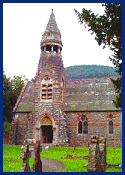 to the practices of worship had an influence in the long term.
Churches like the new parish church at Abbey Cwmhir in Radnorshire (left)
reflect some of the High Church influence of this time.
to the practices of worship had an influence in the long term.
Churches like the new parish church at Abbey Cwmhir in Radnorshire (left)
reflect some of the High Church influence of this time.
The nonconformists’ resentment at having to pay tithes to a church
they had rejected, and their increasing local power through
elections onto new local government bodies all put further pressure
onto the established church in Wales.
After much bitter debate a separate Church in Wales was created
in 1920, which was not part of the state and which lost much of its
wealth. Soon after, Bishop Alfred Edwards of St. Asaph was chosen as
the first Archbishop of Wales. In 1923 the new Province of Wales
created the diocese of Swansea and Brecon from parts of the
sprawling diocese of St David’s, and a new diocese of Monmouth was
created out of parts of the industrial populations of the diocese of
Llandaff.
New English arrivals
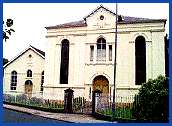
During the nineteenth century the nonconformist denominations had to
respond to the large English or English-speaking influx into Wales as
the rapidly growing industries
recruited a larger workforce. The Calvinistic Methodists and
Independents established new English medium chapels. In the new
urban centres chapels were built which were increasingly grand in
scale, like the typical example shown (right) in
Ystradgynlais, and chapels became a focal point for social
activities in the community. Through their active Sunday schools
they also played an important role in local education.
|
|
|
|
|
|
A vital role in many lives
It is important to remember that in the late nineteenth and early
twentieth century heyday of the nonconformist movement, the chapel
was at the centre of the lives of thousands of people.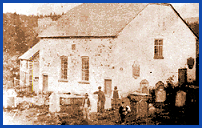
They would meet together for worship and for other gatherings in
grand urban buildings like the chapel pictured on the previous page
and in modest wayside chapels like the one at Newbridge-on-Wye,
Radnorshire in the old photograph shown here, meeting both
the spiritual and social needs of families.The photograph below
shows a gathering for a baptism at Newbridge during the dominant
years of non-conformism.
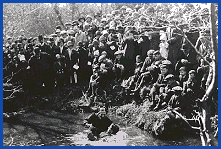
A
long slow decline
Gradually though, developments in science and technology and the
spread of Darwinism did lead to a shift away from fundamentalist
attitude in some sects and sin and damnation were heard of less in
sermons.
The great Revival of 1904/5 did produce a groundswell of
nonconformist belief and an extra 80,000 members joined
denominations in Wales. By 1912, however, three quarters of these
had drifted away and the trend since then has been for a long slow
decline with chapels closing across the nation.
|
|

|
Photographs by
kind permission of
Radnorshire Museum
|
|
Text and
Pictures © Powys Digital History Project
|
|
|
|
Please see our
Home Page
for important copyright notice |
|
|
|
|
|
|
 |
|

|
|
|

|
|
|
|
|
SEARCH THIS SITE |
|
|
This
site has been constructed by, and remains the copyright of,
its authors,
Edwin and Sheila Macadam,
Shelwin, 30, Eynsham Road, Botley,
Oxford OX2 9BP
|
|
| ©
July 2001 -
|
|


 Llandegley
(right), both examples
being in remote locations.
Llandegley
(right), both examples
being in remote locations.
 an
groups were established with leaders like Thomas Coke of Brecon
being active in creating a Welsh Mission.
an
groups were established with leaders like Thomas Coke of Brecon
being active in creating a Welsh Mission. He
was a supporter of Welsh language preaching in church and was behind
the creation of the Cambrian Societies which organised local eisteddfodau.
Clergy in border parishes like Kerry and Abergavenny were active
in safeguarding Welsh literature and culture.
He
was a supporter of Welsh language preaching in church and was behind
the creation of the Cambrian Societies which organised local eisteddfodau.
Clergy in border parishes like Kerry and Abergavenny were active
in safeguarding Welsh literature and culture. the problems of earlier years like the non-residence of
parish clergy, and this was a period of tremendous church
construction as parishes were re-drawn to meet the needs of a
changing population.
the problems of earlier years like the non-residence of
parish clergy, and this was a period of tremendous church
construction as parishes were re-drawn to meet the needs of a
changing population. to the practices of worship had an influence in the long term.
Churches like the new parish church at Abbey Cwmhir in Radnorshire (left)
reflect some of the High Church influence of this time.
to the practices of worship had an influence in the long term.
Churches like the new parish church at Abbey Cwmhir in Radnorshire (left)
reflect some of the High Church influence of this time.

